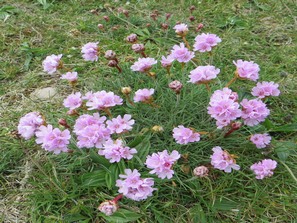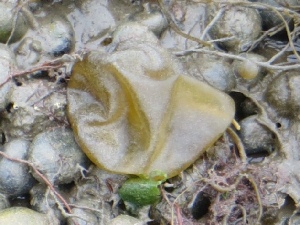


|
Pebbles |
Chesil Beach is a ridge of pebbles sitting on a bank of sand and clay. The pebbles are graded in size from fist- |
|
Percolation |
Water can percolate into, out of, and through Chesil Beach. At spring low tide many streams of water can be seen emerging from the beach and running into the Fleet. Under storm surge conditions the rate of percolation through the beach increases considerably, and can lead to the formation of canns. |
|
Pillboxes |
A large number of pillboxes were built along the Fleet and Chesil Beach shoreline during WWII as part of the fortifications against a possible invasion. Many have now gone, but a significant number still remain. The Defence of Britain Project has mapped many of the military installations and can be accessed here. Visit the pillbox website by clicking here for details of the different types of pillboxes. The ones along Chesil are mostly type 22 and 26, with a few type 25's. |
|
Pinks |
Known locally as Portland Pinks, The thrift, Armeria maritima, is an abundant flower of the southern part of Chesil Beach. When in flower in May it covers the area adjacent to the Chesil Beach Centre at Ferrybridge with a carpet of pink. |
|
Pipeline |
During WW2 a water pipeline was installed along Chesil Beach to bypass Ferrybridge to ensure a continued water supply to Portland. It ran from the caravan park undre the Fleet then along the back of the beach. It then crossed the car park to join the main pipe to Portland. The control valves can still be seen to the right at the end of the walkway from the car park to the beach. |
|
Pirates Cove SY657769 |
The bay just on the south side of the Narrows. Much used by families in the summer and good for snorkelling. |
|
Portland |
Portland anchors the southern end of Chesil Beach. It is a large limestone promontory stretching out into the English Channel. |
|
|
|
|
Portland raised beaches |
The raised beaches can be found each side of Portland Bill. Although now separated from Chesil Beach by some miles, the pebble make- |

|
Oil pollution |
Chesil Beach is susceptible to oil pollution from accidents in Lyme Bay. If the oil got into the pebbles it would prove impossible to remove. There is also a danger of oil getting into the Fleet from an accident in Portland Harbour. Booms are available to protect the entrance to the Fleet and at Abbotsbury Swannery |
|
Oil tanks |
There used to be a large collection of oil tanks on the Mere at the southern end of Chesil Beach. The first tanks appeared in 1907 and most were in place by 1930. A few changes were made as the heliport was developed to make way for hangars and to store aviation fuel. Since the closure of the navy heliport in 1996 the tanks have been steadily removed. All of the tanks have now gone to make way for the Sailing Academy and an industrial estate. Look at the postcards section of this website to see how the tank farm was developed, and then taken down. |
|
Olympics |
The sailing events of the 2012 Olympics were staged out of Portland Harbour. The land base was the RYA sailing school on the site of the Mere behind the southern end of Chesil Beach. The development included reclaiming land from Portland Harbour and building a harbour enclosed by a breakwater built of Portland stone. The Olympic rings carved in Portland Stone originally deployed just off the sailing school can now be see on New Ground near the Portland Heights Motel. |
|
Ownership |
Chesil beach has three major owners: From Portland to the boundary stone at Littlesea it is owned by the Crown Estates, From the boundary stone to West Bexington it is owned by Ilchester Estates, and from West Bexington to West Bay it is mostly owned by the National Trust. The bed of the Fleet is wholly owned by the Ilchester Estates. |
|
Oyster Farm |
There is now a commercial oyster farm on the sandbanks on the north side of the lower Fleet. The species farmed is the Pacific oyster, rather than the local oyster. The racks are clearly visible at low tide. |
|
Oyster thief |
The oyster thief (Colpomenia peregrina) is a type of algae (seaweed) that grows on a solid holdfast. When fully grown it contains sufficient buoyancy to float away with the holdfast. It gets its name from growing on oysters, then floating away with them still attached. It regularly washes up on the shores of the lower Fleet in late winter/early spring. |






|
Quadrant shelter |
These were small brick- |
